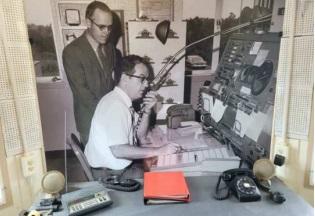MILAN, N.M. – According to the Western New Mexico Airway Heritage Museum in Milan, a significant part of New Mexico’s history comes from when the community was part of the Transcontinental Airways. In 1920, mail took about three days to cross the United States by train. That same year, the US postal service created the first Transcontinental Air Mail Route. This spanned across the country from New York to San Francisco. This system combined daytime flights with nighttime express rail service. With this system, daylight airmail took around two days to be delivered. This still wasn't as efficient as they had wanted so in 1923, Congress funded the lighting of the Transcontinental Airway. This was the world's first civilian ground-based air navigation system. This included 51 feet tall steel towers with a rotating beacon that was visible for 40 miles out. These Airway Beacons were sited every 10 to 15 miles to light the way for nighttime airmail. The towers were also built upon an arrow-shaped concrete slab that would point in the direction of the next beacon for aid in daylight navigation as well. Each site's number was also painted on its generator hut for daylight airmail. At night the beacon’s course lights would flash the site number in Morse code. In 1927, the Post Office transferred all of its airmail routes to the new Airways Division in the Commerce Department’s Bureau of Lighthouses. In 1939, the Federal Airway System, operated by the Civil Aeronautics Authority, included 22,000 miles of lighted airways with 1,950 rotating beacons and 275 intermediate landing fields. In 1943, New Mexico came in eighth for the total number of rotating, numbered airway beacons in a state with 60 of them standing. New Mexico achieved this number with three designated airways in the state.
Today, abandoned beacon sites still exist across the airway along with several historic crash sites. A 1929 Transcontinental Air Transport Tri-Motor crash on Mount Taylor led to a 2009 aviation archaeology project by the US Forest Service. This is what sparked the idea for an airway history museum. The Western New Mexico Aviation Heritage Museum is located next to the Grants-Milan Airport. The site recreates the Los Angeles-Amarillo Airway Beacon 62, located just to the south on San Rafael Mesa in the Zuni Mountains.
The Cibola County Historical Society uses this space to tell the story of the region’s beacons and airfields, the planes that flew the route, and all the people who made it possible, including those who built and maintained it. The museum is open on Saturdays from 9 a.m. to 1 p.m. There is also the outside walking tour that is always available. Bob Roland from the Cibola County Historical Society stated that the Historical Society, along with the museum, runs on a volunteer basis. Currently there are only about five people who trade out time with each other to operate everything. He said that if anyone is interested in helping out to maintain and teach the history of the area, they are welcome to come to the Cibola County Historical Society to volunteer.

